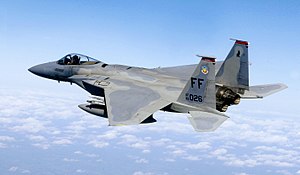F-15A Eagle
| F-15 Eagle | |
|---|---|
 |
|
| USAF F-15C during Operation Noble Eagle patrol | |
| Role | Air superiority fighter |
| Manufacturer |
McDonnell Douglas Boeing Defense, Space & Security |
| First flight | 27 July 1972 |
| Introduction | 9 January 1976 |
| Status | In service |
| Primary users |
United States Air Force Japan Air Self-Defense Force Royal Saudi Air Force Israeli Air Force |
| Number built | F-15A/B/C/D/J/DJ: 1,198 |
| Unit cost |
F-15A/B: US$27.9 million (1998)
F-15C/D: US$29.9 million (1998) |
| Variants |
McDonnell Douglas F-15E Strike Eagle McDonnell Douglas F-15 STOL/MTD Boeing F-15SE Silent Eagle Mitsubishi F-15J |
The McDonnell Douglas F-15 Eagle is an American twin-engine, all-weather tactical fighter aircraft designed by McDonnell Douglas (now Boeing) to gain and maintain air supremacy in aerial combat. Following reviews of proposals, the United States Air Force selected McDonnell Douglas' design in 1967 to meet the service's need for a dedicated air superiority fighter. The Eagle first flew in July 1972, and entered service in 1976. It is among the most successful modern fighters, with over 100 victories and no losses in aerial combat, with the majority of the kills scored by the Israeli Air Force.
The Eagle has been exported to Israel, Japan, and Saudi Arabia. The F-15 was originally envisioned as a pure air superiority aircraft. Its design included a secondary ground-attack capability that was largely unused. The aircraft design proved flexible enough that an all-weather strike derivative, the F-15E Strike Eagle, was later developed and entered service in 1989. Plans to keep the F-15 in U.S. Air Force service past 2025 have been questioned by U.S. Air Force officials in 2017. Newer models are still being produced for foreign users. The F-15 production line is set to end in 2019, 47 years after the type's first flight.
The F-15 can ultimately trace its origins to the Vietnam War, when the U.S. Air Force and the U.S. Navy fought over tactical aircraft being used in the war. At the time, Defense Secretary Robert McNamara was pressing for both services to use as many common aircraft as possible, even if there were performance sacrifices involved. As part of this policy, the USAF and Navy were involved in the TFX (F-111) program, aiming to deliver a medium-range interdiction aircraft in Air Force use that would also serve as a long-range interceptor aircraft for the Navy.
...
Wikipedia
